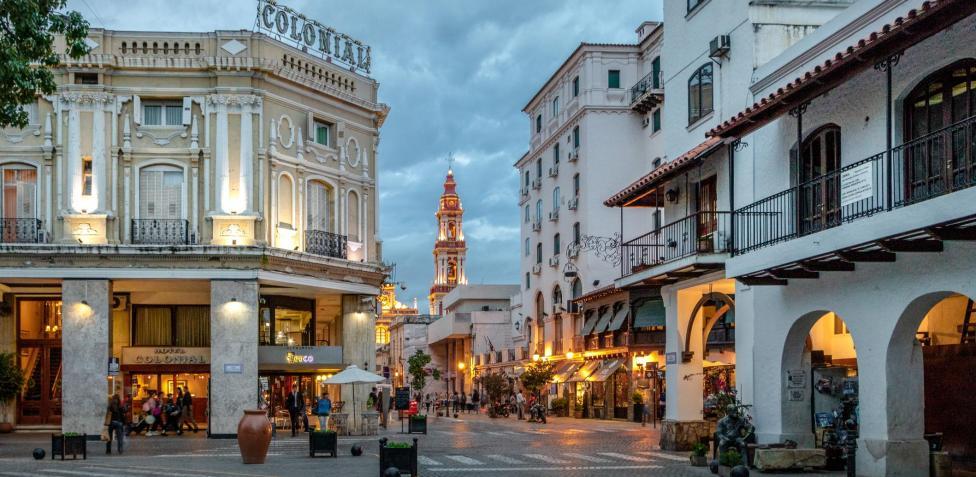Although Salta is the biggest city in Argentina’s otherwise sparsely populated northwest, it retains its small town charm, where perfectly-preserved Colonial-era architecture and vibrant cultural traditions conspire to lend the city a romantic glow that evokes a different, more sophisticated age.
Founded in 1582, Salta’s long history contrasts the debilitating War of Independence in the 17th Century, with an influx of immigrants from Spain, Italy, Syria and Lebanon in the late 19th and 20th centuries. This multicultural influence gives rise to comparisons between Salta and the Andalucían cities in Spain.
For aficionados of classic South American culture, Salta is home to colourfully painted houses with wrought iron balconies and cloistered hallways, cobbled streets, plaza-side cafés, terracotta roofs and live folk music.
The city centre’s Plaza 9 de Julio is lined with handsome trees and bordered by a plethora of cafés. The square is a hub where you will always find something going on, whether it is a concert, a protest or an art show.
Within walking distance are the city’s three pedestrian streets, Alberdi, Florida and Caseros. These streets form the vibrant heart of Salta’s nightlife and are lined with bars, restaurants and cafés. If rising with the sun is your style then make your way to San Bernardo Hill where you can get an awe-inspiring view of the city, and the entire Lerma valley, easily reached by car, gondola or stairway.
Salta provides visitors with a unique opportunity to familiarise themselves with the communities, history, architecture, arts, entertainment and cultural infusion that makes Argentina so captivating. Local life in Salta treasures the rhythms of centuries past; a daily siesta from 1-5pm exemplifies the pace and values integral to the city.
One of the country’s most important folk artists, Eduardo Falú was born in Salta and was influenced by the region’s indigenous music. In addition to its distinct musical sound, the Quechan influence in Salta spreads to a more traditional style of dress and spicier food.
Nestled in the foothills of the Andes Mountains, Salta is Argentina’s eco-tourism getaway offering plenty for the adventurous – fishing, horseback riding, hiking, bird watching and windsurfing.
There are an abundance of things to see and do in Argentina, but in Salta the more relaxed, local feel will pull you into experiencing the small, unexpected moments that will make your trip more memorable.
Whether it’s taking in the panorama of the city from San Bernardo Hill or wandering through Plaza 9 de Julio before sampling empanadas and wine from Cayafate, there is no shortage of activities that will make you feel more acquainted with Argentina.
Other Salta travel highlights include:
The Museum of High Mountain Archaeology (MAAM) – The centrepiece of its collection are the three mummified children from around 500 years ago recovered from atop Llullaillaco Peak. The museum offers fascinating insight into Inca history. It focuses on the archaeology of the Andean mountains, a place that was sacred to the Incas and the site of religious rituals. Don’t miss out on the remarkable Mountain Archaeology Hall and the Inca World Hall.
April Culture Festival – This festival offers a wide variety of activities to celebrate the founding of the city. Expect a month brimming with parties, cultural performances, a handicraft exhibition, and live orchestral concerts. One of the best times to visit during the year, especially since during March and April the days are generally clear and warm.
La Casa de Hernández House – A beautifully whitewashed historical building from 1879, which offers cultural shows and houses the City Museum on its lower level. The museum houses a good collection of musical instruments and numerous displays of paintings and photographs chronicling Salta’s history. Entry is by voluntary donation.
La Casona del Molino – A former mansion and now a sprawling restaurant with several spacious rooms. It is home to impromptu music sessions where groups of musicians gather around a table to sing impassioned folk songs. It stays open until the very early morning on weekends. Find it just outside the city at Luis Burela 1
Iglesia San Francisco – This magnificent church with striking white pillars is one of Salta’s most famous landmarks. You’ll often find it adorning postcards. Guided tours start every half hour from 9.30am.
Virgen de los Tres Cerritos – A hilltop chapel, which is also a pilgrimage site where you’ll find crowds of devotees on Saturdays. On Saturdays there are also free minibuses up the hill.
Tolar Grande – A rural village close to Salta. A great way to get under the skin of the local history and culture. The scenery is spectacular – salt hills that turn russet at sunset, a vista that is dotted with volcanoes and the unending expanse of the salt lake Arizaro.
Museo Pajcha Arte Etnico – A small museum just 10 or 15 minutes walk from the city centre. It is brimming with an exceptional collection of ethnic art and artefacts.
Salta Tram – Takes you up to San Bernardo hill. A must do for beautiful vistas of the city and Lerma Valley. Journey takes around 7 minutes. There is a small restaurant at the top.
Train to the Clouds – This railroad reaches almost 14,000 ft in the air and is one of the three highest in the world. Expect mind blowing scenery. The trip is 8 hours. For altitude sickness, small bags of coca leaves are for sale. Try to get seats on the left-hand side.



